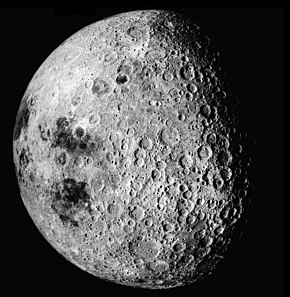
Back Entstehung des Mondes ALS أصل نشأة القمر Arabic Паходжанне Месяца Byelorussian চাঁদের উৎপত্তি ও পরিবর্ধন Bengali/Bangla Entstehung des Mondes German Origen de la Luna Spanish Ilargiaren jatorria Basque Formation de la Lune French Bunús na Gealaí Irish चंद्रमा की उत्पत्ति Hindi

The origin of the Moon is usually explained by a Mars-sized body striking the Earth, creating a debris ring that eventually collected into a single natural satellite, the Moon, but there are a number of variations on this giant-impact hypothesis, as well as alternative explanations, and research continues into how the Moon came to be formed.[1][2] Other proposed scenarios include captured body, fission, formed together (condensation theory, synestia), planetesimal collisions (formed from asteroid-like bodies), and collision theories.[3]
The standard giant-impact hypothesis suggests that a Mars-sized body called Theia impacted the proto-Earth, creating a large debris ring around Earth, which then accreted to form the Moon. This collision also resulted in the 23.5° tilted axis of the Earth, thus causing the seasons.[1][irrelevant citation] The Moon's oxygen isotopic ratios seem to be essentially identical to Earth's.[4] Oxygen isotopic ratios, which may be measured very precisely, yield a unique and distinct signature for each Solar System body.[5] If Theia had been a separate protoplanet, it probably would have had a different oxygen isotopic signature than proto-Earth, as would the ejected mixed material.[6] Also, the Moon's titanium isotope ratio (50Ti/47Ti) appears so close to the Earth's (within 4 parts per million) that little if any of the colliding body's mass could have been part of the Moon.[7]
- ^ a b Cite error: The named reference
nasa1was invoked but never defined (see the help page). - ^ Staff (September 7, 2014). "Revisiting the Moon". New York Times. Retrieved September 8, 2014.
- ^ Theories of Formation for the Moon
- ^ Wiechert, U.; Halliday, A. N.; Lee, D.-C.; Snyder, G. A.; Taylor, L. A.; Rumble, D. (October 2001). "Oxygen Isotopes and the Moon-Forming Giant Impact". Science. 294 (12): 345–348. Bibcode:2001Sci...294..345W. doi:10.1126/science.1063037. PMID 11598294. S2CID 29835446.
- ^ Scott, Edward R. D. (December 3, 2001). "Oxygen Isotopes Give Clues to the Formation of Planets, Moons, and Asteroids". Planetary Science Research Discoveries Report: 55. Bibcode:2001psrd.reptE..55S. Retrieved 2010-03-19.
- ^ Nield, Ted (September 2009). "Moonwalk" (PDF). Geological Society of London. p. 8. Retrieved 2010-03-01.
- ^ Zhang, Junjun; Nicolas Dauphas; Andrew M. Davis; Ingo Leya; Alexei Fedkin (25 March 2012). "The proto-Earth as a significant source of lunar material". Nature Geoscience. 5 (4): 251–255. Bibcode:2012NatGe...5..251Z. doi:10.1038/ngeo1429.